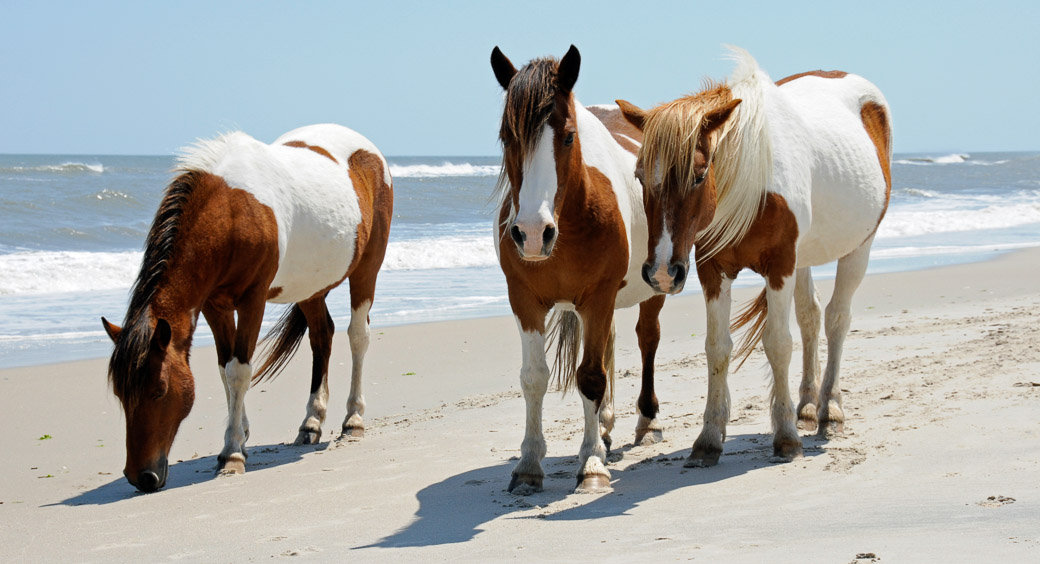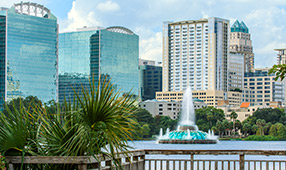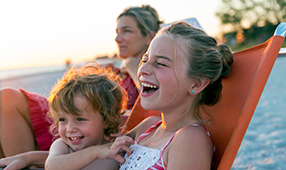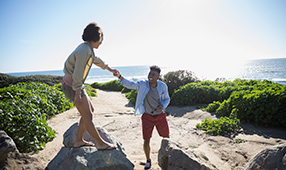This summer, many of us will take to the road for a little break close to home. With plenty of national and state parks that offer beachfront campgrounds, this could be the year to pitch a tent and enjoy the salty air and star-studded night sky. These beautiful parks, which allow you to camp right on the beach, need to be on your beach camping wish list right now.
1. Find peace on the Gulf shores of Florida

Skip the glitz of South Florida and instead head to the sparkling white sands and turquoise waters of Dr. Julian G. Bruce St. George Island State Park on the Gulf Coast. This insider’s paradise is known for its 2,023 acres at the end of a long, narrow barrier island surrounded by the Gulf of Mexico and Apalachicola Bay, and is a combination of sandy beaches, dunes and coves, as well as salt marshes, shady pines and oak forests. Hike, kayak and canoe to explore the area and keep a lookout for marine and bird wildlife.
Campgrounds right on the beach are equipped with electricity, bathrooms and hot water. Reserve ahead (sites are $24/night plus a $6.70 reservation fee; Florida residents 65 and over get a 50% discount).
NEA member discounts on travel: You’ll need to fly to either Tallahassee International Airport (TLH) or Northwest Florida Beaches International Airport (ECP), each are about 1.5 hours away from Apalachicola. Search for the best airfare on NEA Travel’s portal. You can also get great deals on car rentals there.
Plan your itinerary: Apalachicola Bay Chamber of Commerce | Visit Florida | Dr. Julian G. Bruce St. George Island State Park | Dr. Julian G. Bruce St. George Island State Park Campground
2. Wild horses and miles of wild shoreline in Maryland

There’s no room for boredom at the majestic Assateague Island National Seashore. Kiting, kayaking, swimming and marveling at the wild horses who inhabit the island are favorite daytime activities here. After dark, grab your flashlights and scout for ghost crabs.
Camping at Assateague is modern yet rustic. There are clean bathrooms, outdoor showers and fire pits, and you can replenish supplies by day in nearby Berlin. Try to reserve a site with drive-up parking on the Atlantic side. Bayside sites are more protected, but less scenic. Advance reservations are required March 15 through November 15. (Sites start at $30/night, in addition to the park entry fee, and there is a 50% discount for campers with Golden Age, Interagency Senior, Golden Access or Interagency Access passports.)
NEA member discounts on travel: The closest major airport to Assateague Island, Baltimore Washington International Airport (BWI), is still nearly three hours’ drive away. Book your flight through the NEA Travel portal for the best prices and then check the portal for a rental car to get to the island.
Plan your itinerary: Worcester County Tourism | Visit Maryland | Assateague Island National Seashore
3. Beachcomb and eat local in Michigan

When the water level is low in Lake Michigan Fisherman’s Island turns into a peninsula, but the shores at Fisherman’s Island State Park are as lovely as ever. Comb the beaches for fragments of petrified coral known as Petoskey stones. Stroll among the wooded dunes. Relax into a sunset over Lake Michigan. In summer and fall, pick up fruits, veggies and handmade bread at the Charlevoix Farmers Market and check out First Fridays in downtown Charlevoix (just 4 miles away), where families can enjoy giveaways, food from local restaurants, shopping, live music and kid-friendly activities.
The campground is rustic, but beachside campsites fill up fast, so reserve early. (Sites start at $17/night.)
NEA member discounts on travel: Use NEA Travel’s portal to get the best deals on your flight into Cherry Capital Airport (TVC) in Traverse City, which is 42 miles away from Fisherman’s Island, or it’s a four hour drive from Detroit Metropolitan Wayne County Airport (DTW). You can also use the portal to rent a car and get discounted pricing, plus use and earn Travel Dollars.
Plan your itinerary: Visit Charlevoix | Pure Michigan | Fisherman’s Island State Park | Fisherman’s Island Rustic Campground | Charlevoix Farmers Market | Charlevoix First Fridays
4. Cool off in Washington State

The Washington coast is known for mist-shrouded heaps of driftwood and gorgeous forested bluffs. You’ll find all three at First, Second and Third beaches, just outside La Push on the Olympic Peninsula (check road and trail closures carefully before setting out as recent landslides have caused some damage).
Introduce your children to the life of tide pools, explore the sea stacks and watch for sea lions, otters and whales. Then, sit back to relish the changing light. Waters are brisk year-round, so bring warm clothes if you plan to swim.
While these primitive campsites used to be walk-in, reservations for wilderness camping permits are now required due to COVID-19. (Permits run $8 per person per night for adults over 16, plus a flat $6 reservation fee. Children are free.) Call about renting a bear canister (if you don’t have your own) to safely store your food. And, be sure to carry a water filter.
NEA member discounts on travel: Fly into Seattle-Tacoma International Airport (SEA) and from there the park is about a 2.5 hour drive that includes a ferry ride. For great deals on airfare and car rentals, check NEA Travel’s portal.
Plan your itinerary: Olympic Peninsula Tourism Commission | Experience Washington | Mora and Rialto Beach | Olympic National Park Wilderness Permit
5. Drink in the California Pacific

With more than 100 miles of coastal wilderness, Point Reyes National Seashore deserves more than a day trip. In spring and summer, head to the observation deck of the lighthouse to see a colony of around 12,000 common murres on the rocks north of the lighthouse and look for harbor seals and sea lions as well. It’s also a great vantage point to scan the water for the gray whales that migrate north from Mexico and can be seen here January through early May. Just east of the Lighthouse Visitor’s Parking Lot is Sea Lion Overlook, where you can see hundreds of sea lions sunbathing on the shore. In fall, you’ll find tule elk bugling on Tomales Point Trail. Between December and March, take a shuttle to the Elephant Seal Overlook.
All the park’s campgrounds are walk-in, bike-in or boat-in only. For backcountry campsites, these are deluxe, with tables, grills, food lockers and potable water. But it’s the colossal views that keep visitors coming back, and reservations are a must. Plan at least six months ahead for summer trips. (Sites start at $20/night. Contact the park before arrival to make sure the campgrounds are open. There have been closures due to coronavirus and the Woodward Fire in 2020.)
NEA member discounts on travel: The nearest airport is Charles M/ Schulz—Sonoma County Airport (STS) but San Francisco International Airport (SFO) and Oakland International Airport (OAK) are not much farther away. Norman Y. Mineta San Jose International Airport (SJC) and Sacramento International Airport (SMF) are also options. To get the best prices on airfare and car rentals, check NEA Travel’s portal.
Plan your trip: Visit Marin | Visit California | Point Reyes National Seashore | Point Reyes national Seashore Campground Permit
Make your time on the beach unforgettable—in a good way
Before setting out to camp on the beach, remember these essentials:
- Water (go easy on yourself and the planet by packing reusable containers)
- Flashlights and headlamps
- Dry matches and lighters
- A good camp stove
- First-aid kit
- A tent with a functioning rain fly, ground cover and long beach stakes
- Printed tide charts and maps (don’t rely on your phone)
Follow these tips to ensure smooth sailing and maximum savings:
- Test your gear before leaving home.
- Call the ranger station or check the park website to learn about restrictions or closures that might affect your trip.
- Reserve a campsite to avoid last-minute hotel rooms.
- Check the weather and pack appropriately. A windbreaker is always a good idea on the beach. Bring flip-flops and walking shoes, and warm clothing for the evening.
- Protect yourself from sun and summer insects. Carry sunscreen, hats, insect repellent and balm to soothe burns and bites.
- Shop ahead for food and fuel, and make every meal a picnic.
- Know how to protect your food from wildlife.
- Invest in good camp chairs and sleeping pads, and don’t forget pillows.












